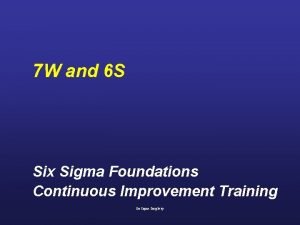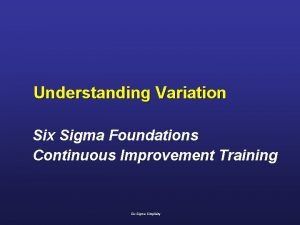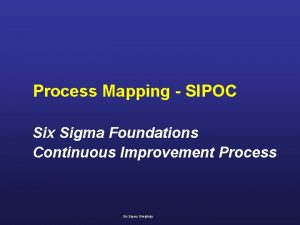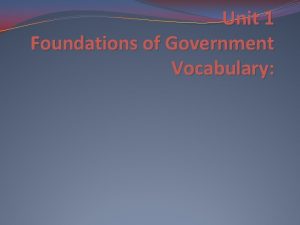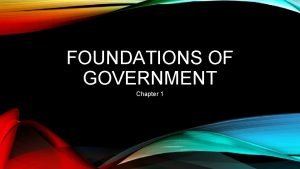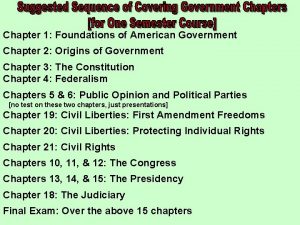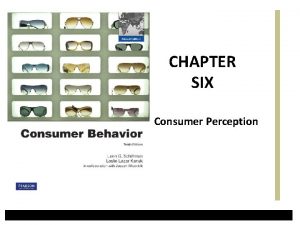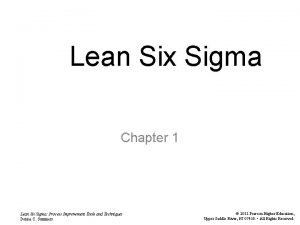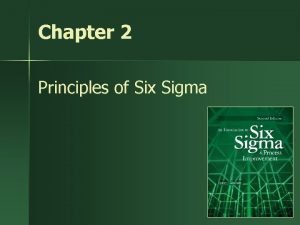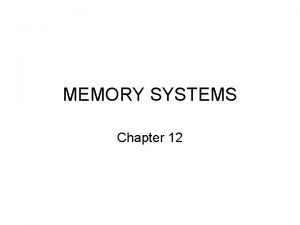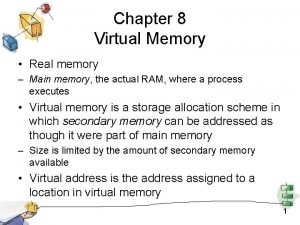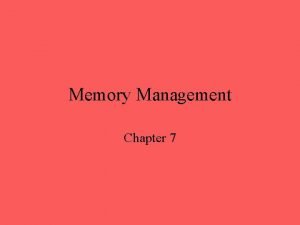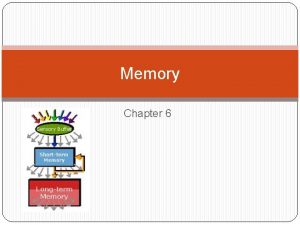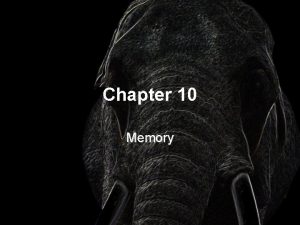CHAPTER SIX MEMORY 1 The Foundations of Memory
































































- Slides: 64

CHAPTER SIX: MEMORY 1

The Foundations of Memory What is memory? Are there different kinds of memory? What are the biological bases of memory? 2

Memory in the Brain 3

Memory Process by which one encodes, stores, and retrieves information Figure 1 of Chapter 6 4

Three-System Memory Theory Sensory Memory Short-term Memory Working Memory Long-term Memory 5

Three-System Memory Theory Three-System Approach to Memory Figure 2 of Chapter 6 6

Sensory Memory Iconic Memory Reflects information from the visual system Echoic Memory Stores auditory information coming from the ears The “Yes Dear” Syndrome 7

Sensory Memory: A Demo Letters flashed quickly Write down all letters Copyright © 2005 Allyn & Bacon

G P C S W Y R X J K M V Copyright © 2005 Allyn & Bacon

The Sperling Technique Letters flashed quickly Arrow appears next to one row Write down letters from that row Copyright © 2005 Allyn & Bacon

L V P G M C X R O S K Q Copyright © 2005 Allyn & Bacon

G M Q Z B V P J R K D E Copyright © 2005 Allyn & Bacon

Y F G C U I D H K X B M Copyright © 2005 Allyn & Bacon

What Sperling Showed Full report (first trial) 3 -4 correct Partial report (later trials) 3 -4 correct (any row) SM has a large capacity and short duration Attention plays a key role in moving information from SM to STM Copyright © 2005 Allyn & Bacon

Short-Term Memory Properties Short duration (a few seconds) Small capacity (7+2 items) Useful for Remembering telephone numbers Language use Getting information to long-term memory Copyright © 2005 Allyn & Bacon

Extending STM We use strategies to extend STM Increasing capacity Chunking Increasing duration Rehearsal Copyright © 2005 Allyn & Bacon

Short-term Memory The memory store in which information first has meaning Chunk ▪ A meaningful grouping of stimuli that can be stored as a unit in short-term memory ▪ Example: 1 K 7 G 7 B 6 F 1 B 81 C 2 I 1 A 8 U 6 S 4 A 17

Short-term Memory The prior example in chunks: KGB, FBI, CIA, USA 1776, 1812, 1864 18

Rehearsal: Extending STM Duration Rehearsal Elaborative rehearsal ▪ Information is considered and organized in some fashion Silent repetition keeps STM refreshed Works until you are interrupted Rehearse enough, and STM moves to LTM Memory curve ▪ Primacy effect (LTM) ▪ Recency effect (STM) 19

Rehearsal: An Example To call your friend Jenny: Step 1. Find her telephone number. “… 867 -5309, 867 -5309…” Step 2. Walk to the telephone. Step 3. Dial the telephone.

The Memory Curve

The Memory Curve: A Demo Remember the following words. After the word done write down every word you remember. Copyright © 2005 Allyn & Bacon

Ready Ring Tree Rope Wall Pen Nail Roof Monk Nose Lake Pear Lock Wax Store Done Copyright © 2005 Allyn & Bacon Chair Box Car Door Rose Wing Clam

Count Them Up Group A: Early Ring, Monk, Chair, Tree, Nose, Box, Rope Group B: Middle Lake, Car, Wall, Pear, Door, Pen, Lock Group C: Late Rose, Nail, Wax, Wing, Roof, Store, Clam Copyright © 2005 Allyn & Bacon

Working Memory The set of temporary memory stores that actively manipulate and rehearse information ▪ Central executive processor ▪ Visual store ▪ Verbal store ▪ Episodic buffer 25

Working Memory (WM): How the Mind Uses STM We manipulate the contents of STM Problem solving Verbal STM Planning WM includes Central executive Verbal STM Visuospatial STM Other STMs Visuospatial STM Copyright © 2005 Allyn & Bacon

Working Memory Model of Working Memory

Long-term Memory Modules Declarative memory ▪ Factual information ▪ Semantic memory General knowledge and facts ▪ Episodic memory Events Procedural memory ▪ Skills and habits 28

Long-Term Memory Properties (Very) long duration ▪ Hours to decades (Very) large capacity ▪ Always room for new memories Copyright © 2005 Allyn & Bacon

Long-term Memory Subcategories of Long-term Memory Figure 4 of Chapter 6 30

Explicit LTM: Semantic versus Episodic Semantic Word meanings (a dog is an animal) Concepts (heat rises) General facts (my dog is named Walter) Episodic Events that occurred to you (buying a dog) Include context (when, where) Copyright © 2005 Allyn & Bacon

Explicit LTM: Semantic Child Afraid Bitter High Moon Table Lost Shell Gun Van Flesh Ache Sweep Never Give Judge Sunday War Cinder Vest Dune Linen Letter Film Syrup Sailor Saber Fog Storm Bow Gentle Germ Relax Pebble Trophy Music Branch Bucket Winter Aged Cited Hard Class Demonstration Copyright © 2005 Allyn & Bacon

LTM: Semantic – Class Demonstration List the months of the year in alphabetical order in under thirty seconds. Difficult because they were never encoded in this manner Copyright © 2005 Allyn & Bacon

Implicit versus Explicit LTM Explicit memory Conscious awareness; easy to verbalize Includes semantic and episodic Implicit memory No conscious awareness; hard to verbalize Includes skills or habits (how to ride a bike) Copyright © 2005 Allyn & Bacon

• The study of implicit memory is relatively new • Amnesiacs who have lost some or all of their ability to recall past experiences were studied and asked for recollections of past events, the amnesiac patients could not An Interesting Lecture Extension • However, when amnesiac patients were asked to complete a task, that they had prior experience performing, they showed enhanced performance Source: Warrington, EK. , Weiskrantz, L. , (1968). New method of testing long-term retention with special reference to amnesiac patients. Nature, 217, 972 -974

Long-term Memory Semantic Networks Mental representations of clusters of interconnected information ▪ Spreading activation 36

Long-term Memory Semantic Memory Networks for Fire Engine Figure 5 of Chapter 6 37

Long-term Memory The Neuroscience of Memory Hippocampus Amygdala Figure 6 of Chapter 6 38

Recalling Long-Term Memories What causes difficulties and failures in remembering? 39

Disorder Alert

Retrieval Cues Recall A specific piece of information must be retrieved Recognition Occurs when one is presented with a stimulus and asked whether he has been exposed to it previously or is asked to identify it from a list of alternatives 41

Levels of Processing Levels-of-processing Theory Suggests that the amount of information processing that occurs when material is initially encountered is central in determining how much of the information is ultimately remembered 42

Breadth of Processing We can encode new information in simple or elaborate ways Simple encoding: repeating information Elaborative encoding: creating connections to existing knowledge Elaborative encoding leads to better memory Copyright © 2005 Allyn & Bacon

Flashbulb Memories related to a specific, important, or surprising event that are so vivid they represent a virtual snapshot of the event Example: ▪ September 11 th, 2001 44

Depth of Processing We can process new information in simple (shallow) or complex (deep) ways Shallow: based on sensory characteristics Deep: based on meaning Complex processing leads to better memory Copyright © 2005 Allyn & Bacon

Flashbulb Memories College Students’ Most Common Flashbulb Memories Figure 7 of Chapter 6 46

Memory in the Courtroom: The Eyewitness on Trial Mistaken identity Impact of Weapons Specific wording of questions Children witnesses 47

Memory in the Courtroom: The Eyewitness on Trial Accuracy of Eyewitness Testimony Affected by Questioner’s Word Choice Figure 8 of Chapter 6 48

Repressed and False Memories: Separating Truth from Fiction Repressed and False Memories Recollections of events that are initially so shocking that the mind responds by pushing them into the unconscious Memories may be inaccurate or even wholly false. Controversy regarding their legitimacy 49

Creating False Memories

Autobiographical Memory: Where Past Meets Present Recollection of circumstances and episodes from our own lives One tends to forget information about one’s past that is incompatible with the way in which one currently sees oneself. 51

Autobiographical Memory: Where Past Meets Present Autobiographical Memories of Grades Recalled by College Students Figure 9 of Chapter 6 52

Forgetting: When Memory Fails Why do we forget information? What are the major memory impairments? 53

Why We Forget Failure of Encoding Did not pay attention to material Decay Loss of information through nonuse ▪ Memory traces 54

Why We Forget Interference Information in memory disrupts the recall of other information Cue-dependent Forgetting Occurs when there are insufficient retrieval cues to rekindle information that is in memory 55

Forgetting Decay Memories fade away over time Interference Retroactive: new information makes it harder to remember old information Proactive: old information makes it harder to learn new information Copyright © 2005 Allyn & Bacon

The Stroop Test Identify the words below beginning on left and row by row 57

The Stroop Test Identify the words below beginning on left and row by row 58

Improving Memory Do not believe claims about drugs that improve memory. Effective strategies Organization cues Keywords Elaborative rehearsal Effective note taking 59

Proactive and Retroactive Interference: The Before and After of Forgetting Proactive Interference Information learned earlier disrupts the recall of newer material. Retroactive Interference Difficulty in the recall of information because of later exposure to different material 60

Proactive and Retroactive Interference: The Before and After of Forgetting Proactive and Retroactive Interference Figure 11 of Chapter 6 61

Memory Dysfunctions: Afflictions of Forgetting Alzheimer’s Disease Amnesia Retrograde Anterograde 62

Disorder Alert

You Tube Connection
 Sigma simplicity
Sigma simplicity Six sigma foundations
Six sigma foundations Six sigma foundations
Six sigma foundations Download six sigma foundations
Download six sigma foundations Classify each polygon
Classify each polygon What are the three c's of healthy relationships
What are the three c's of healthy relationships Chapter 6 skills for healthy relationships
Chapter 6 skills for healthy relationships Describe the care team and the chain of command
Describe the care team and the chain of command Foundations of individual behavior
Foundations of individual behavior Chapter 1: foundations of government
Chapter 1: foundations of government Chapter 4 foundations background to american history
Chapter 4 foundations background to american history Foundation in personal finance chapter 1 answers
Foundation in personal finance chapter 1 answers Foundations of government vocabulary
Foundations of government vocabulary Chapter 1: foundations of government pdf
Chapter 1: foundations of government pdf Foundations of government (chapter 1 test form a)
Foundations of government (chapter 1 test form a) Assuming a 1 kb page size
Assuming a 1 kb page size Hình ảnh bộ gõ cơ thể búng tay
Hình ảnh bộ gõ cơ thể búng tay Bổ thể
Bổ thể Tỉ lệ cơ thể trẻ em
Tỉ lệ cơ thể trẻ em Gấu đi như thế nào
Gấu đi như thế nào Tư thế worms-breton
Tư thế worms-breton Hát lên người ơi alleluia
Hát lên người ơi alleluia Môn thể thao bắt đầu bằng chữ đua
Môn thể thao bắt đầu bằng chữ đua Thế nào là hệ số cao nhất
Thế nào là hệ số cao nhất Các châu lục và đại dương trên thế giới
Các châu lục và đại dương trên thế giới Công thức tính thế năng
Công thức tính thế năng Trời xanh đây là của chúng ta thể thơ
Trời xanh đây là của chúng ta thể thơ Cách giải mật thư tọa độ
Cách giải mật thư tọa độ Làm thế nào để 102-1=99
Làm thế nào để 102-1=99 Phản ứng thế ankan
Phản ứng thế ankan Các châu lục và đại dương trên thế giới
Các châu lục và đại dương trên thế giới Thơ thất ngôn tứ tuyệt đường luật
Thơ thất ngôn tứ tuyệt đường luật Quá trình desamine hóa có thể tạo ra
Quá trình desamine hóa có thể tạo ra Một số thể thơ truyền thống
Một số thể thơ truyền thống Cái miệng nó xinh thế chỉ nói điều hay thôi
Cái miệng nó xinh thế chỉ nói điều hay thôi Vẽ hình chiếu vuông góc của vật thể sau
Vẽ hình chiếu vuông góc của vật thể sau Thế nào là sự mỏi cơ
Thế nào là sự mỏi cơ đặc điểm cơ thể của người tối cổ
đặc điểm cơ thể của người tối cổ V cc cc
V cc cc Vẽ hình chiếu đứng bằng cạnh của vật thể
Vẽ hình chiếu đứng bằng cạnh của vật thể Tia chieu sa te
Tia chieu sa te Thẻ vin
Thẻ vin đại từ thay thế
đại từ thay thế điện thế nghỉ
điện thế nghỉ Tư thế ngồi viết
Tư thế ngồi viết Diễn thế sinh thái là
Diễn thế sinh thái là Dạng đột biến một nhiễm là
Dạng đột biến một nhiễm là Số nguyên tố là gì
Số nguyên tố là gì Tư thế ngồi viết
Tư thế ngồi viết Lời thề hippocrates
Lời thề hippocrates Thiếu nhi thế giới liên hoan
Thiếu nhi thế giới liên hoan ưu thế lai là gì
ưu thế lai là gì Khi nào hổ con có thể sống độc lập
Khi nào hổ con có thể sống độc lập Khi nào hổ con có thể sống độc lập
Khi nào hổ con có thể sống độc lập Hệ hô hấp
Hệ hô hấp Từ ngữ thể hiện lòng nhân hậu
Từ ngữ thể hiện lòng nhân hậu Thế nào là mạng điện lắp đặt kiểu nổi
Thế nào là mạng điện lắp đặt kiểu nổi Episodic memory
Episodic memory Explicit and implicit memory
Explicit and implicit memory Long term memory vs short term memory
Long term memory vs short term memory Internal memory and external memory
Internal memory and external memory Primary memory and secondary memory
Primary memory and secondary memory Logical memory vs physical memory
Logical memory vs physical memory Which memory is the actual working memory?
Which memory is the actual working memory?
